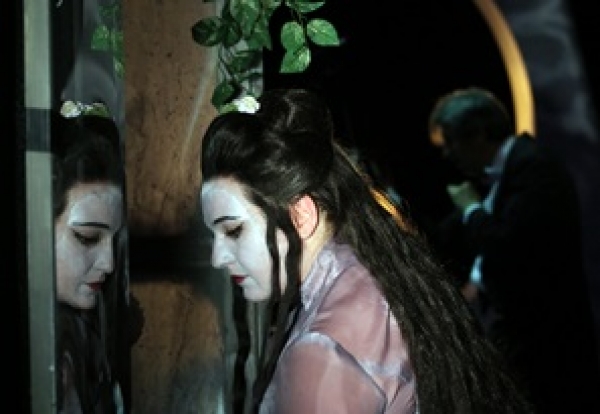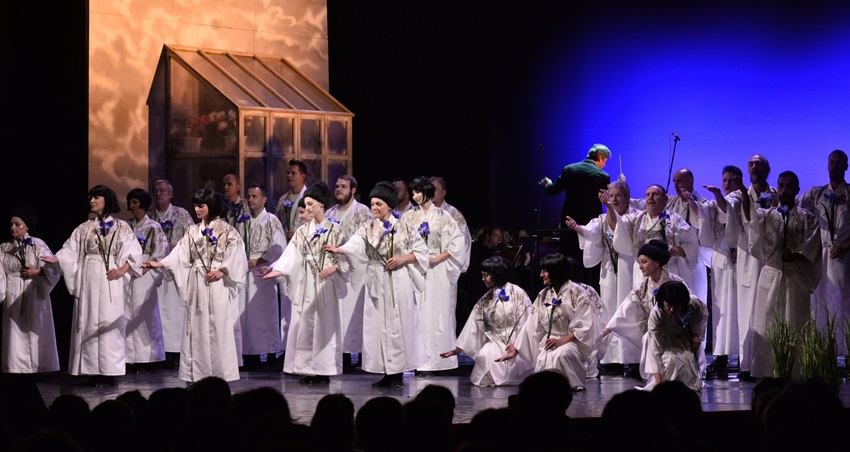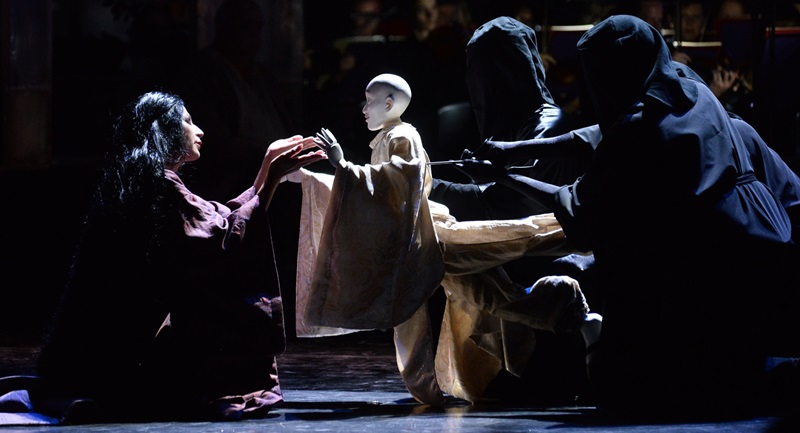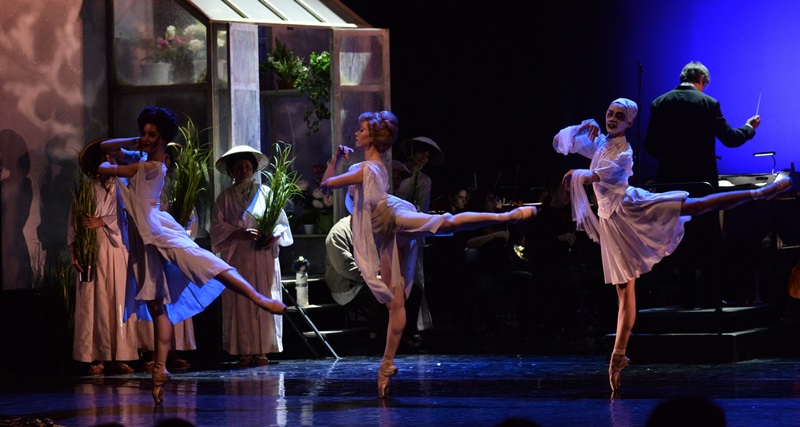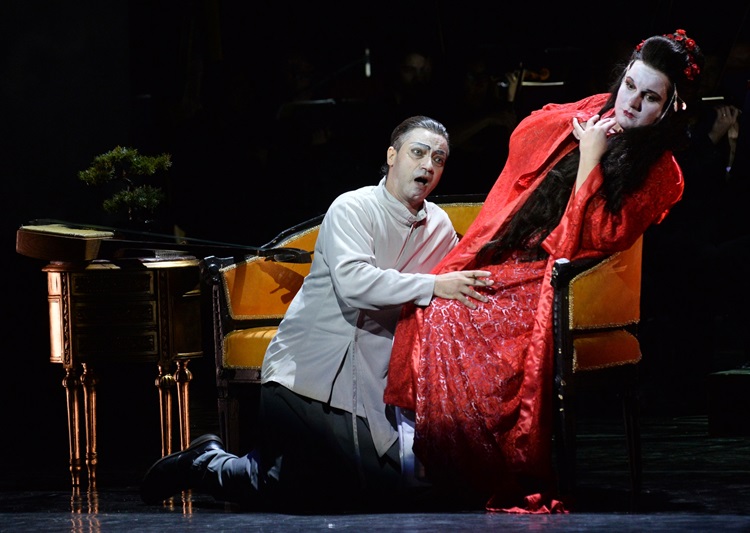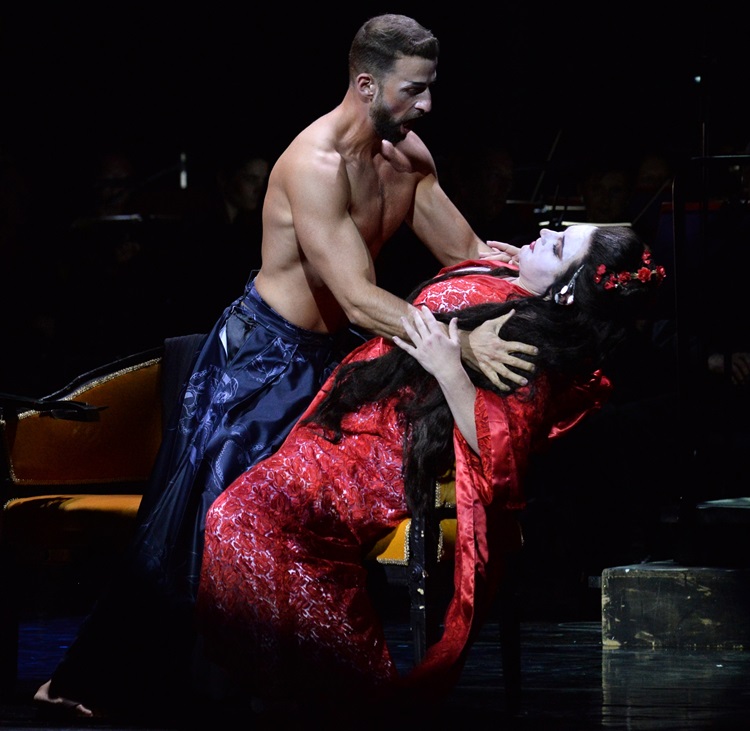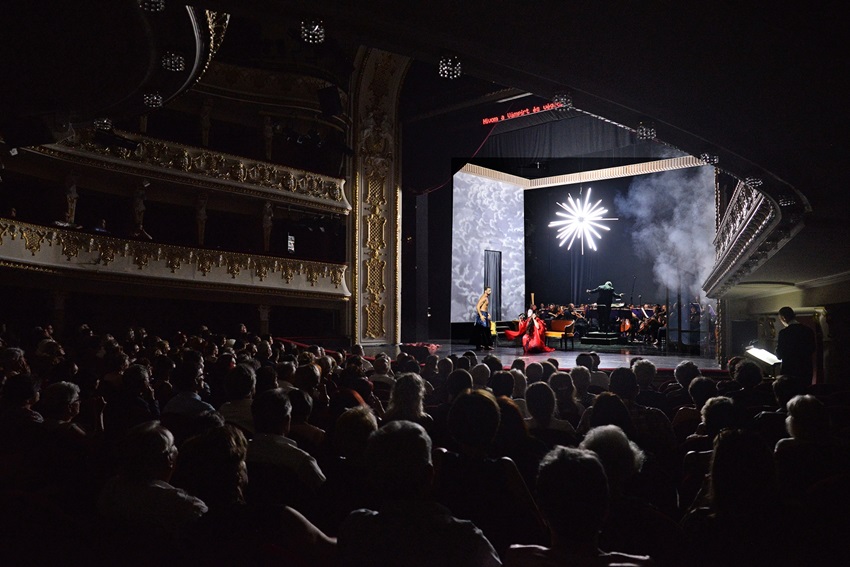Pietro Mascagni's rarely seen opera Iris was played in the guest performance of the Josef Kajetan Tyl Theater (Pilsen, Czech Republic) at the Bartók Plus Opera Festival in Miskolc. Unfortunately, it was a mediocre performance.
*
It must have been a great pain for Mascagni that the success of his first opera Cavalleria rusticana, premiered in 1890, could never be repeated. Towards the end of his life, he said: ’It is a great pity that I wrote Cavalleria rusticana first. I was crowned for it before I became king.’ It is a telling comment. Obviously the audience was expecting a ’new Cavalleria rusticana’. However, listening to the composer's other stage works, such as Iris presented now in Miskolc, it is evident that Mascagni made very serious efforts not to write an opera like Cavalleria rusticana again. He did not want to repeat himself; he looked for new paths. Iris, this ’symbolic music drama’, is an excellent proof that in terms of musical development, Mascagni came a long way in those years following the premiere of Cavalleria rusticana. Perhaps it is no exaggeration to say, based on his musical and dramaturgic innovations, that Iris can be classified as an experimental, avant-garde work of that era. It is another matter that the audience could not be convinced. In terms of popularity, Iris could never compete with the author's first opera, as none of Mascagni's other works could. (It was hardly a comfort to him that, except for Puccini, his contemporary verist composers, e.g. Leoncavallo, Giordano and Cilea, were considered being ’one-opera composers’, too.) Apart from Cavalleria rusticana, only Iris and L’amico Fritz are sometimes performed, including in his native country, Italy. This is also due to the fact that in his later, less popular operas, the composer often makes it very difficult for the singers, especially for the tenor. A good example of this is Il piccolo Marat, which was a success at the premiere with the great Hippolito Lázaro in the title role, but later few tenors dared to take it on. Of course, Mascagni was honored with great respect in Italy already in his life. As a result – though his operas were rarely performed – several excerpts were recorded by the great singers of his time. (For example, we can listen to the tenor arias from Isabeau or Lodoletta by Beniamino Gigli.)
*
The libretto of the three-act Iris was written by Luigi Illica based on his own short story. He was also the librettist of Puccini's Madama Butterfly; both stories take place in Japan. The work was premiered on November 22, 1898, at the Teatro Costanzi in Rome. Iris was sung by Hariclea Darclée (who was also the first Tosca two years later), and Osaka by the legendary tenor, Fernando De Lucia (who also sang on the premiere of several other Mascagni operas).
It may well be that now at the Opera Festival we saw the Hungarian premiere of the work. As the presenter of the evening revealed at the beginning of the performance, according to a brief news published in 1923 the opera was planned to be performed right here, in Miskolc. Unfortunately, we have no information on whether this has really happened. Even if so, it hasn't been performed in Hungary for nearly a hundred years.
*
The story of the work takes place in ancient Japan at an unspecified time. Iris, the naive, innocent, young, beautiful girl who worships the Sun and loves nature, is kidnapped by the rich young adventurer, Osaka, who takes her to a geisha house with the help of his friend Kyoto, a pimp. However, Iris rejects Osaka's advances. Kyoto exposes her to the crowds and humiliates the girl, whose old blind father – in the belief that her daughter has voluntarily become a prostitute – curses her, flinging mud in her face. Heartbroken, Iris throws herself down to the sewer. After her death, the Sun embraces her in eternity.
*
The story balances between reality and myth. Probably this is the main reason why this opera has never enjoyed greater popularity: due to its sophisticated symbolism it has been difficult for it to find the way to the audience. Although the realistic line of the story is easy to follow, it is simple, even too simple. In the larger part of the approximately two-hour work, the symbolic, inner events are more important. The characters of Illica's mysterious libretto are not complicated, either, and apart from Iris, do not evolve as the plot progresses. They are rather symbols of purity and innocence (Iris), the mere desire for sex (Osaka), greed and cruelty (Kyoto). (The name of the title character is also symbolic: the flower iris is otherwise called ’woman’s petal’ in Hungarian.)
The geisha (Jana Foff Tetourová)
Already the abstract message of the famous overture (usually called ‘Inno al Sole’, that is ‘Hymn to the Sun’), performed by the choir, stands outside the plot. (’I am Life! I am infinite Beauty, Light and Warmth!’ – sings the Sun.)
Iris often has hallucinations and dreams. First about a monster which threatens her doll. In her bizarre, strange monologue she fantasizes about a beast living in a dead sea, which moves its tentacles around the legs, the loin, and finally the whole body of a little girl sitting on the shore. The girl dies with a smile as a priest shouts: ’The monster is pleasure, the monster is death!’ (These are remarkable, deep psychological observations – two years before the publication of Freud's The Interpretation of Dreams! – about the unconscious images of suppressed desires.) Iris has a vision again when she wakes up in the geisha house in Tokyo: she thinks she is dead, and she is in the afterlife. In the last act, the girl dying in the canal sees the spirit of the three men (Osaka, Kyoto and the father), whose ‘selfishness’ destroyed her. (The three short scenes were really given these subtitles in the score: ’Osaka’s egoism’, ’Kyoto’s egoism’, and ‘The blind man’s egoism’) In the finale, the soul of the girl becomes one with the Sun. Iris passes through the darkness, and, covered with flowers, she gets up to the Sky; this transcendental union is accompanied by the tunes of the hymn that was already heard at the beginning of the work.
Not only the abstract scenes and monologues of the solo singers and the choir slow down the action, but also the long, meditative orchestral preludes at the beginning of all three acts. It is clear that the slow-paced story, the more lyrical tone, the static scenes and the less linear narrative are far from the compact structure, dynamic tempos, and linear story of Cavalleria rusticana.
It is remarkable, how Mascagni uses the ’play-within-a-play’ technique as a dramaturgic tool in Iris. Osaka, Kyoto and the geishas play a puppet show at Iris' house, distracting her attention to kidnap her. In the puppet play, Osaka impersonates the son of the Sun, Jor, and Iris falls in love with this imaginary figure, only to be shocked to realize later in the geisha house, that Osaka's real personality is very much different.
The work had a strong influence on Puccini whose opera Madama Butterfly was premiered six years later. However, beyond the similarities of the exotic East Asian environment, the differences are more important: in Puccini’s opera we see realistic, flesh and blood figures.
Besides, Iris’s fate is, in some ways, even more sad than Butterfly's: she was not loved by Osaka for a minute, nor by anyone else other than her father. She is lonely; her only true friend is the Sun.
*
The music of Iris is characterized by rich orchestration with East Asian colours, often with entirely impressionist harmonies. The most famous music of the opera is the already mentioned ‘Hymn to the Sun’, which clearly shows the influence of Wagner. The overture, played and sung by the orchestra and the choir, begins with a slow, gentle double bass solo, which gradually develops, unfolds, rises, and finally reaches a high apotheosis, accompanied by the thundering sounds of the timpani and the gongs.
The tenor’s serenade ’Apri la tua finestra’ is also popular, it is sometimes performed at concerts, too. The second act duet of Iris and Osaka (‘Da niuno… Or dammi il braccio...’) is less frequently performed, but it is beautiful.
*
The production of the company of Pilsen was disappointing, although they were only partly responsible for this not very high standard performance. What happened was that the stage of the National Theater of Miskolc proved to be small for the production. The orchestra could not fit in the orchestra pit, so the musicians had to sit on the stage at the back. The conductor was standing right in front of them, and the singers could only watch him on the screens placed in the boxes on both sides. It is likely that the stage would have been too small for the whole scenery, even without the musicians. In any case, the space was narrowed down so much that we actually saw a semi-staged performance, which was only made more dynamic by the scenes of the dancers.
Osaka (Paolo Lardizzone) and Iris (Ivana Veberová)
However, the mediocre performance can only be partly explained by the difficult conditions. The orchestra led by Jiří Štrunc, apart from having some beautiful moments, often played unreasonably erratically and inaccurately. The singer soloists were trying hard, but Tomáš Pilař's stage-direction was very unimaginative. Neither the scenery nor the costumes represented colourfully and faithfully the atmosphere of the Far East.
*
Iris’s role is vocally very demanding. Ivana Veberová was able to cope with it, but I would not say that she gave an outstanding performance. She sang Iris’s solo scenes with pathos and empathy, with more or less secure top notes, but something was missing that could have made her performance truly memorable, both in terms of singing and acting. Unfortunately, it was also hard to imagine that she is a young, fragile girl, which made Iris's stage appearance rather disillusioning.
The role of Osaka is also a challenge for the tenor. The role is characterized by a kind of duality, because while Osaka’s figure is less elaborated, the vocal part is more so. His serenade ’Apri la tua finestra’ in the first act (when Osaka impersonates Jor in the puppet play) is attractive, but not easy to sing effortlessly because of its high tessitura. Paolo Lardizzone sang his part fairly, but he often forced his voice in the aforementioned aria and in the second act duets.
Kyoto (Csaba Kotlár) and Iris (Ivana Veberová)
Csaba Kotlár in the role of Kyoto portrayed an excellent character. The good-looking baritone was a cynical and merciless geisha house owner, and I have nothing to complain about his vocal performance.
Mezzo-soprano Jana Foff Tetourová also made a good impression in the role of Dhia in the puppet scene. Her voice was expressive and controlled; her interpretation of the geisha fallen into a trance was genuine.
Bassist Jevhen Shokalo, who played Iris's old, blind father, was an acceptable choice for the role; he played his role emphatically.
The choir sang with accuracy and with sufficient power, the ‘Hymn to the Sun’ was impressive. (Note: it may not be right to show the choir on the stage in this scene. The ’title’ is misleading: not the people speak to the Sun, but we hear the Sun itself in the voice of the choir, which should therefore sing behind the scenes.)
As I have already mentioned, the scenery and the costumes were quite unimaginative (costume designer: Ivana Shevchik Milošková, set designer: Petr Vítek). The stage-direction did not make use of the potential of the symbolic story taking place in an exotic milieu. The realistic environment, such as Iris’s house with the colourful flowers and the Tokyo brothel with the geishas, or the surreal dreams and mystical scenes offer a whole range of spectacular ideas, by which the slow, sometimes even monotonous plot could have been compensated.
In the absence of these, only outstanding singers could make Iris a real success, but this time they were also missing. The greatest merit of the performance was that at last the Hungarian audience could also meet Mascagni’s unduly neglected masterpiece.
Balázs Csák
photo: Vera Éder
***
June 22, 2019, Miskolc National Theatre, Grand Theatre
Mascagni:
Iris
Opera in two parts, three acts, in Italian
Guest performance of the Josef Kajetán Tyl Theatre (Plzen, Czech)
Libretto: Luigi Illica
Set Design: Petr Vítek
Costume Design: Ivana Ševčík Miklošková
Choreography: Martin Šinták
Conductor: Jiří Štrunc
Directed by: Tomáš Pilař
Cast:
Iris – Ivana Veberová
Il Cieco, father of Iris – Jevhen Šokalo
Osaka – Paolo Lardizzone
Kyoto – Csaba Kotlár
Geisha – Jana Foff Tetourová
Rag trader – Khan Amin
Vampire – Tiszai Adrienn
The Beauty – Plachá Kateřina
Death – Clementi Charlot
Choir and Orchestra of Josef Kajetán Tyl Theatre


